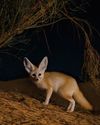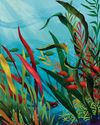يحاول ذهب - حر
The Birth Of Coral
Spring 2019
|BBC Wildlife
We know what is putting the world’s coral reefs in peril today, but what ideal conditions created them in the first place and how can they be maintained?

A ragged crescent of land ringed by the sharp peaks of relatively young volcanoes encloses Kimbe Bay on the north coast ofthe island of New Britain in the southern Pacific.Part of Papua New Guinea, this island, and in particular that bay, is known by marine scientists for its astonishing biodiversity. Within the shelter of a geologically turbulent land mass, awe-inspiring coral reefs teem with oceanic life. This is thought to be the evolutionary birthplace of the world’s coral reefs. What gave rise to this theory is the particular set of topographical features around the bay and the actions of the area’s ocean currents.
New Britain lies north of the Solomon Sea and cups the Bismarck Sea. South of the island, and parallel to it, is the Bougainville Trench, one of the deepest in the region, dropping to more than 9,000m (30,000ft) – deeper than Everest is high. The trench is a long narrow depression in the seabed, marking where a plate in the Earth’s crust is sliding under another, like a wrinkle in a piece of cloth.

Perfect conditions
Trenches gather detritus containing organic matter, nitrogen and phosphorous. Powerful ocean currents stir up that nutrient-rich sediment and carry it to shallower areas. In New Britain and Kimbe Bay, the nutrients from the Bougainville Trench are carried upwards by the South Equatorial Current and northwards around the island.
هذه القصة من طبعة Spring 2019 من BBC Wildlife.
اشترك في Magzter GOLD للوصول إلى آلاف القصص المتميزة المنسقة، وأكثر من 9000 مجلة وصحيفة.
هل أنت مشترك بالفعل؟ تسجيل الدخول
المزيد من القصص من BBC Wildlife

BBC Wildlife
"I was terrified the elephant would ram us"
African elephant in Kenya
2 mins
January 2026

BBC Wildlife
ALL YOU EVER NEEDED TO KNOW ABOUT THE Fennec fox
THE FENNEC FOX IS THE SMALLEST fox in the world, with a body length that can be as little as 24cm.
3 mins
January 2026

BBC Wildlife
INTO THE PLASTISPHERE
A unique synthetic ecosystem is evolving in our oceans – welcome to the plastisphere
7 mins
January 2026

BBC Wildlife
“More than half of all animal life exists in a parasitic relationship, and all life lives in symbiosis”
Our survival depends on species evolving to live together - but some relationships take dark turns
7 mins
January 2026

BBC Wildlife
Are animals able to dream?
SLEEP IS A MYSTERIOUS THING. FOR A long time, we weren't sure why we do it.
1 mins
January 2026

BBC Wildlife
Does a cuckoo know it's a cuckoo?
ABSURD LITTLE BIRDS ACROSS THE world lay their eggs in the nests of other species, leaving the hapless parents to raise a changeling at the expense of their own offspring.
2 mins
January 2026

BBC Wildlife
Orcas killing young sharks
Juvenile great whites are easy prey for orca pod
1 mins
January 2026

BBC Wildlife
Ocean goes on tour
Acclaimed film touring the UK, backed by live orchestra and choir
1 min
January 2026

BBC Wildlife
Feisty bats hunt like lions
Winged mammals use a 'hang and wait' strategy to take down large prey
1 mins
January 2026

BBC Wildlife
SNAP-CHAT
Richard Birchett on magical merlins, wily coyotes and charging deer
2 mins
January 2026
Translate
Change font size
